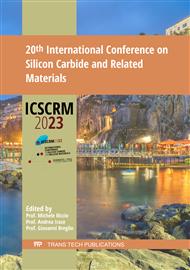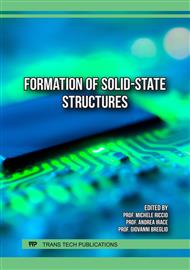p.7
p.13
p.21
p.29
p.35
p.41
p.47
p.53
p.59
Dopant Activation Comparison in Phosphorus and Nitrogen Implanted 4H-Silicon Carbide
Abstract:
Bulk mobility and dopant activation of implanted species into 4H-SiC plays a crucial role in the carrier conduction, blocking behavior, and channel properties of a 4H-SiC vertical power MOSFET. Nitrogen and phosphorus ion implantation became the norm as n-type dopants for 4H-SiC. Therefore, the doping and temperature behavior of both species in 4H-SiC needs to be well characterized. In this study, we report a comparison in electrical characteristics between nitrogen and phosphorus implanted 4H-SiC as a function of temperature for various doping levels. For this purpose, 4-point van der Pauw samples are prepared, resistivity and Hall measurements are conducted. We found that resistivities drop as temperature increases from 140 K with phosphorus having higher resistivities at all implanted doping concentrations. The carrier concentrations increase with increase of temperature, indicating incomplete ionization of dopants. Mobilities drop at low temperature due to increased impurity scattering, reaches a peak near 300 K and drops at higher temperature due to increased phonon scattering. From the obtained data, using a two-level charge neutrality equation, the activation percentage and ionization energies of dopants in hexagonal and cubic sites for both species are extracted and compared.
Info:
Periodical:
Pages:
35-39
Citation:
Online since:
August 2024
Keywords:
Permissions:
Share:
Citation:



